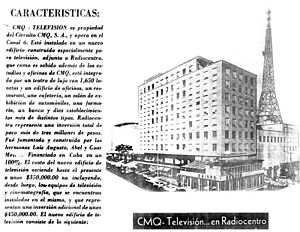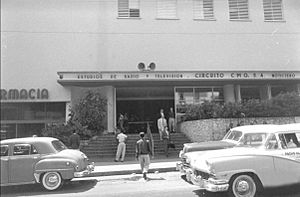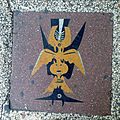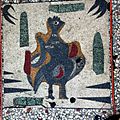Radiocentro CMQ Building facts for kids
Quick facts for kids Radiocentro CMQ Building |
|
|---|---|

CMQ logo,1950
|
|
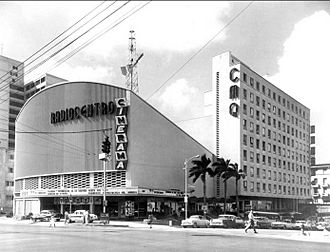 |
|
| Alternative names | CMQ |
| General information | |
| Type | Radio & television studios, commercial, offices, movie theatre |
| Architectural style | Modern |
| Location | El Vedado |
| Address | 363 Calle L, (btwn L y M) El Vedado, Havana |
| Town or city | |
| Country | Cuba |
| Coordinates | 23°8′24″N 82°23′0″W / 23.14000°N 82.38333°W |
| Estimated completion | 1947 |
| Owner | Goar and Abel Mestre |
| Height | |
| Roof | 35 metres (115 ft) |
| Technical details | |
| Structural system | Steel frame |
| Material | Concrete |
| Floor count | 10 |
| Floor area | 21,802 m2 (234,670 sq ft) |
| Lifts/elevators | 3 |
| Grounds | 6,254 m2 (67,320 sq ft) |
| Design and construction | |
| Architect | Martín Domínguez Esteban, Miguel Gastón and Emilio del Junco |
| Structural engineer | Purdy and Henderson, Engineers |
| Designations | CMQ |
| Known for | First mixed use building in Havana |
The Radiocentro CMQ Building is a famous building in El Vedado, Cuba. It used to be a place where radio and TV shows were made. It also had offices. The building is located where Calle L and La Rampa meet. It was designed to look like the Rockefeller Center in New York City.
The building opened on December 23, 1947. It had a large theater with 1,650 seats. It was first called Teatro Warner Radiocentro. Brothers Goar and Abel Mestre owned it. Today, the building is the main office for the Cuban Institute of Radio and Television (ICRT).
Contents
Building the Radiocentro CMQ
Building the Radiocentro CMQ was special. In 1947, the city of Havana changed its rules for El Vedado. Before, buildings could not be taller than three floors. But for this building, they allowed it to be taller. Six years later, the rule changed again. Buildings could then be up to four floors high. This was because many builders wanted to make taller buildings.
The building was set back five meters from the street. It also had a four-meter arcade, which is like a covered walkway. This created space from the road. It also helped with the steep slope of 23rd Street. The arcade became a wide gallery and part of the basement.
This gallery led to the cinema's entrance. The cinema was on the corner with Calle L. The building had a cool, curved design that stood out. A restaurant on the other corner, on M. Street, had a similar design. The wide gallery also led to the office building's lobby. A third part of the building, on M Street, was also set back. This made the two corners of the building stand out even more.
What Was Inside the Building?
The cinema inside the building could hold 1,700 people. It was a special Cinerama theater. This meant it used three projectors and a huge, curved screen. The screen was twenty-five feet wide. The cinema also had a small stage. Short shows were sometimes put on there to entertain people before the movies.
The radio station CMQ had offices in the ten-story building. This part of the building also had space for future TV studios. These studios were not built yet when the building first opened. One of its studios, Studio Number 2, was very important. Not only were radio shows broadcast from there, but it was also where most of the RCA Victor music recordings in Cuba happened from 1948 to 1959. Discuba was a Cuban record label started by RCA Victor in 1959. It released music by famous artists like Celia Cruz, Beny Moré, Orquesta Aragón, and La Lupe.
The ground floor of the building was for everyone. It had many different shops. There were exhibition halls, a bank, a restaurant, and a cafeteria. The way the building was designed made sure that people walking through would pass by these shops.
CMQ Radio and La Tremenda Corte
The radio show La Tremenda Corte was very popular. It aired non-stop from 1942 to 1961. It was first on RHC Cadena Azul and then on CMQ. Vispo was the only writer for the show. He wrote over 360 episodes! Many of these shows are still heard on the radio today.
Some episodes recorded at CMQ in Havana between 1947 and 1961 are very rare. Fans and collectors value them highly. When the show was most popular, the actors traveled to other countries. They performed in places like Puerto Rico, Venezuela, and Colombia. They were very famous.
Building Design and Style
The Radiocentro CMQ Building was built in 1947. It was the first mixed-use building in Cuba. This means it had different types of spaces. It included businesses, offices, radio and TV studios, and the Cinerama Warner cinema.
The building was designed by a team. The structural engineers were from the U.S. firm Purdy and Henderson, Engineers. The architects were Martín Domínguez Esteban, Miguel Gastón, and Emilio del Junco. They were all part of ATEC, the Cuban section of the CIAM. The building was so important that it was even featured in a famous magazine called L'Architecture d'aujourd'hui.
The building looks like a series of separate boxes. It was designed by the architect Martín Domínguez Esteban. He also designed the Hipódromo de la Zarzuela in Spain. The CMQ Building was inspired by Raymond Hood's Rockefeller Center.
The Radiocentro CMQ Building had a big impact on other buildings in Cuba. Many architects who liked Modern architecture were influenced by it. Later buildings like the Hotel Habana Hilton (now Hotel Habana Libre) and the Edificio del Seguro Médico, Havana were built with similar ideas.
Walter Gropius, a famous architect, visited Havana in 1949. He talked about the Radiocentro CMQ Building. He said it showed why architects need to work together as a team. He believed that no single architect could know everything needed for a big building.
The FOCSA Building
In 1952, the CMQ Radio and TV Network wanted to build more. They planned new offices, a radio station, and homes for their employees. CMQ bought a large piece of land for this project.
The company Fomento de Hipotecas Aseguradas (FHA) helped pay for the homes and shops. El Banco Continental Cubano gave a large loan.
Martín Domínguez Esteban worked with Ernesto Gómez-Sampera to design the FOCSA Building. This was another modern project. It aimed to provide housing for CMQ workers and more radio stations. Construction started in February 1954 and finished in June 1956.
When it was built, the FOCSA Building was the second-largest concrete residential building in the world. Only the Martinelli Building in São Paulo, Brazil, was bigger. It also became Cuba's tallest building, taller than the López Serrano Building. The FOCSA Building has some similar design features to the Edificio del Seguro Médico, Havana, built in 1958.
The Salon de Mayo Art Exhibition
In 1943, during World War II, a group of artists in Paris started an art group. They wanted to show modern art, which the Nazi party called "Degenerate art". They called their group the Salon de Mai. Their first art show was in May 1945.
More than 20 years later, in July 1967, the Salon de Mayo came to Havana. It was the group's first art show in America. The exhibition was organized by Carlos Franqui. Famous artists like Wifredo Lam, René Portocarrero, Alexander Calder, Joan Miró, and Pablo Picasso helped.
The show featured works by over one hundred artists. It included different styles of 20th-century art. Fifteen artists created original designs for sidewalk mosaics. These mosaics were made of colored granite. Architects Fernando Salinas and Eduardo Rodríguez helped with the technical parts. The mosaics were made by mixing colored cement with crushed marble. Then they were polished. Bronze sheets separated the designs. Each mosaic was about 14 to 18 inches square. There were 15 different designs repeated over several blocks, totaling 180 mosaics.
-
Salón de Mayo, 1967. Rene Portocarrero.
-
Salón de Mayo, 1967. Amelia Peláez.
-
Salón de Mayo, 1967. Wifredo Lam.
You can still see these art mosaics today. They are on the sidewalks along Calle L and Calle 23. These are in front of the Radiocentro CMQ Building, which is now called Yara Cinema. Artists like Wifredo Lam, René Portocarrero, and Amelia Peláez contributed designs.
The 1957 Presidential Palace Attack
The Radiocentro CMQ Building played a role in a big event in Cuban history. This was the Presidential Palace Attack in 1957. More than fifty people died in this event.
Faure Chaumón Mediavilla, one of the attack leaders, explained the plan. The main goal was to attack and kill Fulgencio Batista at his office. This office was in the Presidential Palace. About fifty men were part of this attack.
At the same time, over one hundred other men would help. Some would take over the Radio Reloj station at the CMQ complex. Their job was to announce that Batista was dead. They hoped this news would make the people of Havana start a general strike. They wanted to encourage an armed rebellion.
José Antonio Echeverría led the attack on CMQ Radio. He was the President of the Federation of University Students (FEU). He planned to make a speech during a popular music program. This way, his anti-Batista message would be heard across Cuba. Echeverría knew they could only hold the radio station for about three minutes. So, he prepared a speech that was very short. He finished his speech in just 181 seconds.
Echeverría managed to leave the station safely. He was on his way to the University of Havana, which was nearby. But his car was stopped by a police car. He was killed during a shootout on the sidewalk near the university.
Otto Hernández Fernández was the last survivor of the Radio Reloj attack. He remembers March 13, 1957:
"The attackers went out in three cars to Radio Reloj. Carlos Figueredo was our driver, with Fructuoso Rodríguez, José Antonio Echeverría, Joe Westbrook, and me. Our plan was for Echeverría to be the only one to reach the door of the CMQ station building. The other two had to block the street at each corner to prevent interruptions. They entered the building with authority. While they went up to the broadcast booth, the driver focused on keeping the car ready. I went out with the machine gun to ensure a safe return. About five minutes later, I saw the doorman start to close a large glass door. Figueredo shot twice from his seat. I went to the CMQ entrance, pointed my gun at the guard, and said, "Don't close, because if you do, I'll open it with bullets." That man froze but didn't close it. A moment later, Jose Antonio and the others came down. They had cut the broadcast and didn't finish reading the message. When we passed the corner of Jovellar and L, we heard a police car siren behind us. Right there, I told Chinese Figueredo to stay quiet and let the patrol pass. Well, he started like a fireball and rammed the police car almost head-on. With the crash, I fell to the ground. But I remember how Jose Antonio quickly opened the door, shooting at the police. Even today, I clearly remember the big man falling almost in front of us."
Images for kids
See also
 In Spanish: Edificio Radiocentro CMQ para niños
In Spanish: Edificio Radiocentro CMQ para niños
- FOCSA Building
- Edificio del Seguro Médico, Havana
- López Serrano Building
- Havana Presidential Palace attack (1957)
- Humboldt 7 massacre
- Directorio Revolucionario Estudiantil


